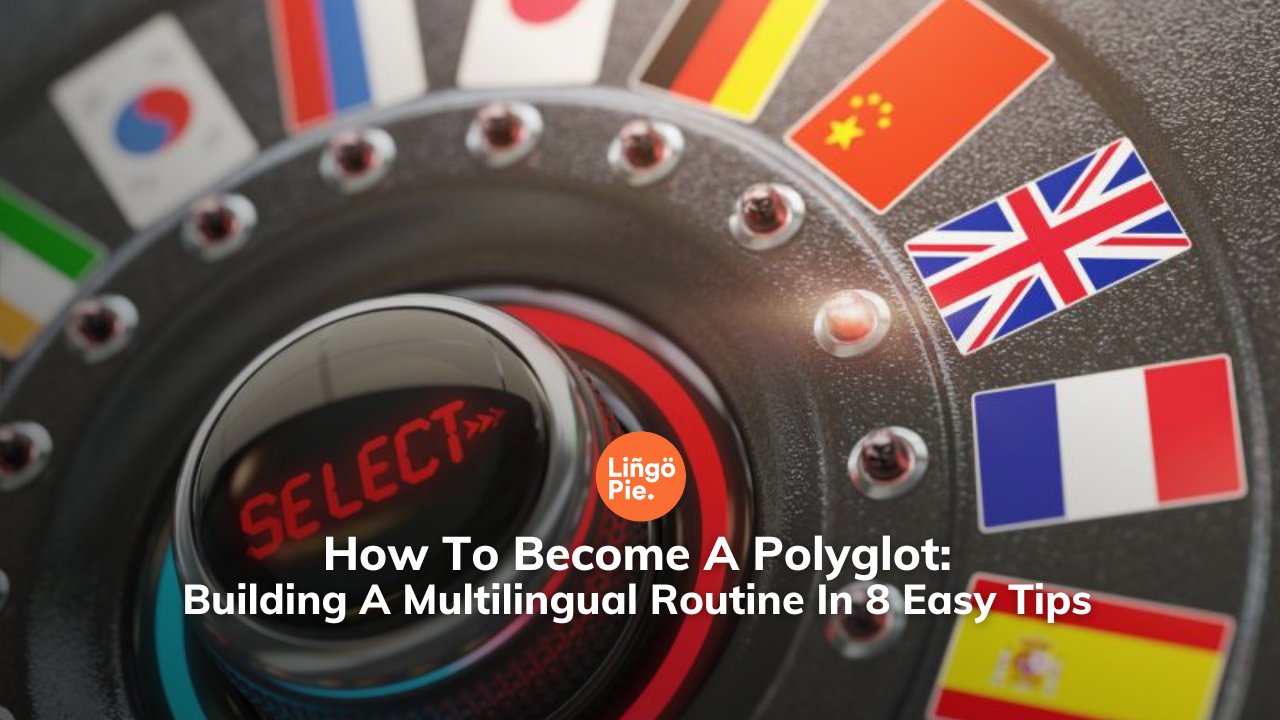Becoming a polyglot is the ultimate dream of people who are passionate about language learning. But the idea of learning multiple languages at the same time may be overwhelming for you.
If you think polyglots are special people with some super cognitive skills and not everybody can become a polyglot, you’re so wrong! Anyone who is motivated and determined to learn foreign languages can become a polyglot. All you have to do is study smart and manage your time wisely!
I know it is easier said than done. That’s why I’ll share some useful tips on how to become a polyglot and learn multiple languages, in this blog post!

What Is A Polyglot?
Let’s take it from the beginning and answer this question first.
The word polyglot is derived from the Greek words “poly” meaning many and “glōtta” meaning language. So, polyglot means someone who has learned multiple languages and has the ability to communicate fluently using these foreign languages.
How Many Languages Do You Need To Become A Polyglot?

To understand how many languages is enough to become a polyglot, you should know the related terms below:
Monolingual: Someone who speaks only one language fluently in everyday life.
Imagine your parents are American and you were born and raised in the US. You only speak English in your everyday life. So you speak one language fluently at native level.
Bilingual: Someone who speaks two languages fluently in everyday life.
Imagine your parents are Arabs who migrated to the US a long time ago. They speak Arabic at home and speak English outside to continue their life. You grew up speaking both Arabic and English in everyday life. So you speak two languages fluently at native level.
Trilingual: Someone who speaks three languages fluently in everyday life.
Imagine your mother is Italian and your father is Turkish and they live in the US. You grew up speaking both Italian and Turkish at home but speak English outside. So you speak three languages fluently at native level.
Multilingual: Someone who speaks more than one language. It is used as an umbrella term. It is sometimes used interchangeably with the term polyglot.
What makes polyglots different from these categories above is that they learn a new language on purpose, as a hobby, or with the intent of learning a foreign language. So, whether you learn four languages or ten languages, you are counted as a polyglot.
Read Also:

How Long Does It Take To Become A Polyglot?
Becoming a polyglot will take years at best. However, it depends on several things such as personal aptness to language learning, your target language difficulty, your native language, how much time you can commit each day, and using the right language learning strategies.
Tips For Building A Multilingual Learning Routine

Now, let’s get to the nitty-gritty part of how to become a polyglot. You need to learn multiple languages to become a polyglot, right? But how do you learn multiple languages at the same time?
Here are eight useful tips from a former language teacher to language learners who want to maintain a multilingual learning routine!
1. Do Not Study Similar Languages Simultaneously
Can you imagine learning Spanish and Portuguese from zero at the same time? They have a lot of similar things in terms of wording, grammar, and sentence structure.
For beginners who have no experience in either languages, it will cause complications. You are likely to get confused and go between the two languages and can’t make sure if a particular word or rule belongs to Spanish or Portuguese.
Therefore, you should learn different languages simultaneously. You can look up language families and pick foreign languages that don’t belong to the same family.
However, if you already have a B2 level in Spanish, then there is no harm in going with Portuguese at the same time because it is not likely that you will confuse them with one another.
2. Master One Language First
This is about the last paragraph I mentioned in the first tip above. If you really want to learn two related languages at the same time, try to master the easiest languages first and once you achieve an at least B1 level, you can move on to the next language.
For mastering one language, I recommend learning a foreign language that belongs to the same language family as your native language. For example, French, Italian, and Spanish are relatively easy to learn for native English speakers.
According to the FSI (Foreign Service Institute) these languages are listed under Category I languages and they take 24-30 weeks to achieve professional working proficiency.
3. Prioritize Languages
You need to prioritize the languages you want to learn based on how much role a particular language will play in your life. For example, if you plan to study abroad in Italy, focus on learning Italian. Or if most of your relatives live in South America and you want to connect with them, then you should focus on learning Spanish.
4. Make A Weekly Study Plan
Learning multiple languages can be tough for someone who has a full-time job or a busy schedule at school. Everyone’s weekly schedule is different; you can’t just follow someone else’s plan.
Language learning equals constant practice. If you are learning multiple languages at the same time, avoid studying two languages in a day. You can dedicate each day to a different language. Decide how much time you will dedicate for each language skill.
5. Set Realistic Goals
Learning multiple languages is already challenging enough and don’t make it even more difficult by pushing yourself to achieve unrealistic goals.
Do not try to achieve the intermediate level in a few months while you have other responsibilities and life going on. Do not try to finish a language textbook in a month. These are unrealistic goals, besides, there is no need to rush yourself while you have a long way to go.
Try to move with baby steps and one thing at a time. Keep your goals at the minimum so that you can overachieve them and feel successful instead of feeling discouraged.
6. Immerse Yourself In Languages
The best proven way to learn a new language is immersing yourself in the target language. Immersing is a language learning strategy that features consuming authentic content.
You should read books, watch movies, and listen to songs in your target languages as much as possible. Because language learning is all about being exposed to input and interpreting them in your brain.
Think about how you acquired -not learned- your native language when you were a baby. You hear the speech of your parents every single day. After some time, you produce meaningless sounds. Then your brain starts matching and interpreting the words you hear. And you start speaking and understanding your first language even though no one is teaching you anything.
This is where the immersion technique comes from. You listen to native speakers as much as possible, be exposed to different cultures, learn new words from movies, try to pronounce them like native speakers, etc.
Immersion is the main idea behind Lingopie which is the best app to learn languages by watching movies and TV shows. It offers 9 foreign languages and a vast library of local TV shows, movies, podcasts, and music for each language. With Lingopie, it is not a dream to learn a foreign language while having fun!
7. Give Equal Importance To All Language Skills
I know some language learners skip a language skill because they think it is not that important or can be boosted later. I think this is a huge mistake a lot of learners make.
If you want to become a fluent speaker in your target language, you should focus on all primary language skills which are reading, writing, listening, and speaking. Because when you ignore one of them, it will be harder to correct the mistakes you make afterwards.
8. Use Laddering And Shadowing Techniques
The laddering technique is one of the best language learning strategies for polyglots. Basically, it is the solution to mixing up words and languages.
Take a pen and paper and draw a ladder that has the same number of rungs as the languages you know. The first rung at the bottom is your native language, let’s say English. The second rung is your second language, Spanish. And the third rung is your third language, Japanese.
- 3. Japanese- 2. Spanish- 1. English
Keep this ladder in mind, and use it every time you need to translate something in your mind. You should use the rung right below the language you speak at that moment. This will help you practice your vocabulary in multiple languages and enhance your cognitive skills.
When it comes to the shadowing technique, it is the best working method for getting native-like pronunciation and accent in a foreign language. This technique is all about mimicking the native speakers.
Watch a Youtube video or TV show in your target language. Imagine you are the main character and repeat every sentence the character says. But pay attention to their pronunciation, intonation, and mouth movements. After applying this method for some time, your mouth muscles will get used to the movements you make when speaking in another language and you will get the correct accent in your target languages.
Ready To Become A Polyglot?
Becoming a polyglot and learning several languages at the same time is not a piece of cake. But if you apply these tips in your multilingual learning routine and have enough motivation and patience, there is nothing to stop you from becoming a polyglot!
If you are looking for a language learning app to learn your target language while having fun, check out Lingopie!
Lingopie is a content-based language learning app that offers 9 languages. Thanks to Lingopie, you can learn a foreign language by watching TV shows and movies. It has a vast library of authentic content for each language including movies, TV shows, songs, and podcasts.
The best part is that it also has a Netflix extension! You can learn new words from your favorite shows by just clicking on the word. You can also add these words to your own vocabulary lists to review and practice later.
Download Lingopie from the App Store or Play Store and start your FREE 7-day trial now!







![4 Hacks to Learn English With Movies [2025 Guide]](/blog/content/images/size/w300/2023/10/88AAD01A-8BF3-4648-82CC-639C1B240C28.png)
![Language Difficulty Ranking For English Speakers [2025]](/blog/content/images/size/w300/2025/05/Language-Difficulty-Ranking----For-English-Speakers.png)
![Language Learning with Netflix [2025 Guide]](/blog/content/images/size/w300/2023/05/Netflix-AD.jpg)
